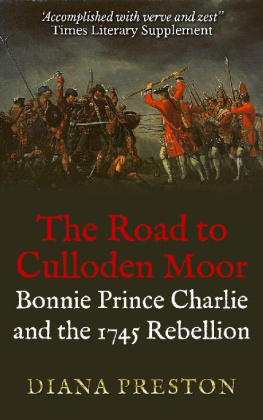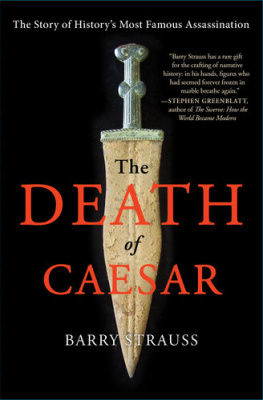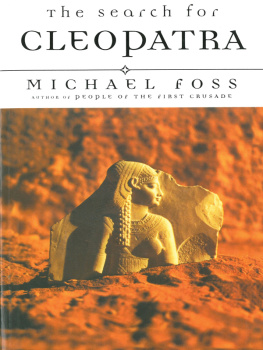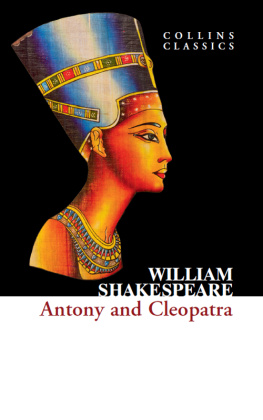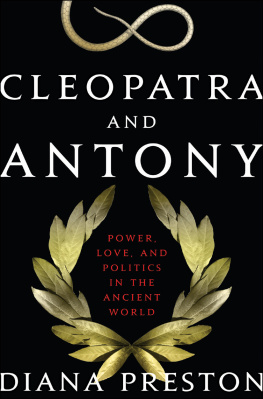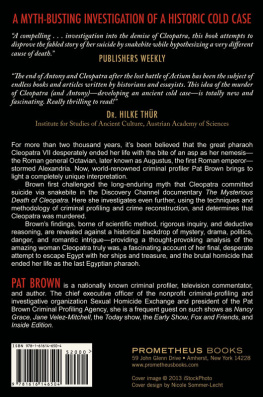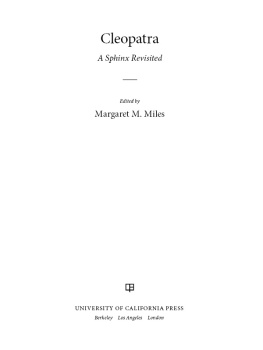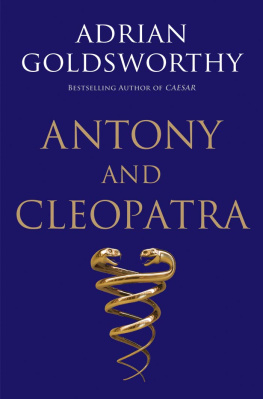CLEOPATRA AND ANTONY
Also by Diana Preston
The Road to Culloden Moor: Bonnie Prince Charlie and the 45 Rebellion
A First Rate Tragedy: Robert Falcon Scott and the Race to the South Pole
The Boxer Rebellion: The Dramatic Story of Chinas War on Foreigners ThatShook the World in the Summer of 1900
Lusitania: An Epic Tragedy
Before the Fallout: From Marie Curie to Hiroshima
By Diana and Michael Preston
A Pirate of Exquisite Mind: Explorer, Naturalist, and Buccaneer: The Lifeof William Dampier
Taj Mahal: Passion and Genius at the Heart of the Moghul Empire
CLEOPATRA
AND
ANTONY
Power, Love, and Politics
in the Ancient World
DIANA PRESTON

Copyright 2009 by Preston Writing Partnership
All rights reserved. No part of this book may be used or reproduced in any manner whatsoever without written permission from the publisher except in the case of brief quotations embodied in critical articles or reviews. For information address Walker & Company, 175 Fifth Avenue, New York, New York 10010.
Published by Walker Publishing Company, Inc., New York
All papers used by Walker & Company are natural, recyclable products made from wood grown in well-managed forests. The manufacturing processes conform to the environmental regulations of the country of origin.
LIBRARY OF CONGRESS CATALOGING-IN-PUBLICATION DATA HAS BEEN APPLIED FOR.
ISBN: 978-0-802-71959-1
First published in somewhat different form in the United Kingdom in 2008 by Transworld Publishers
First U.S. edition 2009
Visit Walker & Companys Web site at www.walkerbooks.com
1 3 5 7 9 10 8 6 4 2
Typeset by Westchester Book Group
Printed in the United States of America by Quebecor World Fairfield
In memory of Henry and Lily
T HEY OPENED THE DOOR, and saw Cleopatra lying dead on a golden couch, dressed like a queen, with one of her two ladies-in-waiting, Iras, dying at her feet. The other, Charmion, was so weak that she could hardly stay upright but she was trying to adjust the diadem which adorned Cleopatras brow. One of the men hissed angrily, A fine deed, this, Charmion! and she replied: Yes, nothing could be finer. It is no more than befits this lady, the descendant of so many kings.
So the ancient historian Plutarch portrayed the death scene on a stiflingly hot day in August 30 BC of the thirty-nine-year-old queen of Egypt, Cleopatra. Captured by Octavian, who would become Augustus, the first emperor of Rome, she had triumphantly taken her destiny back into her own hands. Rather than be paraded in chains through Rome by her conqueror, she had poisoned herself with the bite of a snake. A few days earlier, her lover of eleven years, Mark Antony, bloody and sweat-soaked following his own botched suicide attempt, had died in her arms after she and her waiting women had hauled him painfully into the fortress tomb where she had taken refuge as Octavians victorious armies advanced into the broad, colonnaded streets of the Egyptian capital, Alexandria.
Thus ended the lives of the ancient worlds best-remembered celebrity couplecharismatic figures who died at the height of their fame and whose physical appearance still provokes debate. Their depictions on coins of their time are not flattering. Cleopatra, in particular, appears hawk-nosed and imperious. However, a model of her head created for this book by an archaeologist specializing in facial reconstruction and based on a wider range of evidence offers another imagea woman who, though striking, was also more than a little plump.
Cleopatra and Antony lived unconventionally and to the full. Their deaths were sudden and the subject of conspiracy theories. But their enduring place in our popular consciousness derives from more compelling reasons than our interest in celebrity and romance. Their personal love story was an integral part of a great military, political and ideological struggle, the outcome of which still affects us. Had they triumphed over Octavian and recast Romes territories in both east and west as they planned, the history of the Roman Empire and of what followed might have been very different.
The backdrop to Cleopatra and Antonys story was one of the rise and fall of empires. The once great power of Egypt was waning while that of Rome was aggressively on the rise. Cleopatras Egypt had been founded by her opportunistic Macedonian ancestor Ptolemy I, who was one of the generals of Alexander the Great and also his distant cousin. Ptolemy had taken advantage of the chaos after Alexanders death in 323 BC in Babylon to seize Egypt and start a dynasty. Ptolemy had chosen well in selecting an ancient, established land united for more than three thousand years under its pharaohs. It had good natural defensesinvaders from east and west faced arid deserts, and invaders from the north could only attack by sea. Southward down the Nile, just beyond Aswan, were the tumbling waters of the First Cataract and then the gold-rich lands of Lower Nubia, which, like the pharaohs before them, the Ptolemies swiftly occupied.
At first Ptolemaic Egypt had flourished, but by the time of Cleopatras birth in 69 BC, though it was still wealthy, its political and military fortunes had long been in decline. In need of a powerful protector, the Ptolemies had adopted a policy of appeasing and pleasing Rome but faced the possibility that the expansionist republic, by then the dominant power in the Mediterranean, might gobble up Egypt as just another Roman province. The risk was a real one. Romes only serious rivals for the status of superpower were the Parthiansthe rulers of Persia (Iran) and many other lands besides. Romes ambitions seemed boundless and her military momentum unstoppable. But her internal political tensions would also affect Egypts fate and how Cleopatra and Antonys struggle with Octavian would ultimately play out.
The Roman republic had been founded in 509 BC when the last of Romes kings, Tarquin the Proud, was driven out by citizens under the leadership of one of the Brutus clan claiming that Rome would never again be subject to the tyranny of one man. Rome, though, had become the victim of its own success. By the time of Cleopatra and Antony, the pressures of trying to reconcile a system of government originally designed for a small city-state on the east bank of the River Tibernot only with the requirements of law and order in a rich and fast-growing empire but also with the personal ambitions of power-hungry generals, businessmen and politicianshad become impossible to contain. Although Romes rules of government provided for a form of democracy, albeit imperfect, which gave every male citizen (though not of course their wives, daughters or slaves) some sort of voice, a growing number believed this to be incompatible with Romes growing status. Power, they argued, would be better exercised in the hands of a few men or even in the hands of only one. This ideological debatewhich often spilled out bloodily onto the streetshad become a contest between the collective power of an autocracy personified by the Senate on the one hand and a series of strong men on the other who used their legions to back up their aspirations and bribed or sometimes coerced the people to support them, thus lending their regimes a veneer of legitimacy.
Both Antony and Octavian took part in these struggles, sometimes as allies but, as their ambitions clashed, finally as enemies. Both of them craved power and both circumvented the established structures of government. However, Octavian was the more single-minded and ultimately triumphed. The dual suicides of Cleopatra and Antony effectively marked the death of the long-ailing Roman republic and the rise of personal rule as embodied by the emperor.





